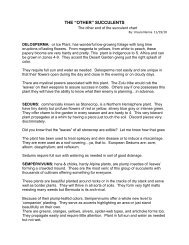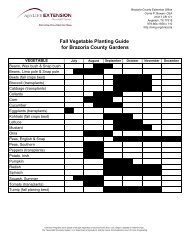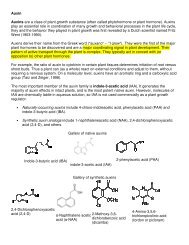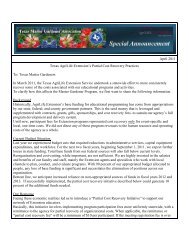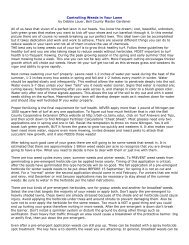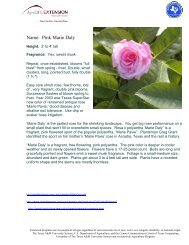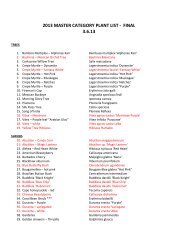Graywater - Texas Master Gardeners Association
Graywater - Texas Master Gardeners Association
Graywater - Texas Master Gardeners Association
Create successful ePaper yourself
Turn your PDF publications into a flip-book with our unique Google optimized e-Paper software.
Figure 7. Settling tank and pump tank for pressurized graywater distribution.<br />
or to separate wastewater streams at<br />
all should be based on an individual<br />
household’s circumstances and on the<br />
purposes for which graywater will be<br />
reused.<br />
<strong>Graywater</strong><br />
system design<br />
considerations<br />
<strong>Graywater</strong> sources<br />
A homeowner first must decide<br />
which household graywater sources to<br />
collect for reuse. Collecting graywater<br />
from all sources increases the risk of<br />
additional solids and other pollutants<br />
being added to the graywater. Each<br />
source contributes different contaminants<br />
due to its particular water com-<br />
position (Table 1). Constituents likely<br />
to be found in a particular graywater<br />
source should be compared to the<br />
intended reuse application for water<br />
from that source. Such evaluation also<br />
helps to identify treatment necessary<br />
prior to graywater reuse.<br />
<strong>Graywater</strong> yields<br />
The amount of graywater a household<br />
generates depends on number of<br />
occupants, their ages, their lifestyle<br />
characteristics and their water-use<br />
patterns and on the potential graywater<br />
sources to be fed into the system<br />
(Table 2). Total amount of graywater<br />
produced varies from site to site and<br />
must be estimated as part of systemdesign<br />
processes.<br />
<strong>Graywater</strong> collection<br />
and storage<br />
In a limited number of situations<br />
(system in existence prior to January<br />
6, 2005), graywater from residential<br />
clothes-washing machines may be discharged<br />
onto the ground using a gravity<br />
flow system. <strong>Graywater</strong> from other<br />
sources should be diverted through<br />
settling tanks and pump tanks for later<br />
treatment and distribution. However,<br />
graywater contains organic matter,<br />
and if it is stored, it will quickly turn<br />
septic, generate offensive odors and<br />
promote growth of pathogenic microorganisms.<br />
Thus, it is critical to size<br />
the graywater settling tank and pump<br />
tank appropriately, so that they do not<br />
hold graywater for extended periods<br />
of time. Generally, to keep graywater<br />
fresh,it should be stored for less than<br />
one day, a critical consideration if<br />
it is to be dispersed onto the ground<br />
surface.<br />
<strong>Texas</strong> graywater rules also require<br />
that graywater be collected in an approved<br />
tank that<br />
is labeled clearly as “non-potable<br />
water”;<br />
restricts access, especially to<br />
children;<br />
eliminates habitat for mosquitoes<br />
and other vectors;<br />
Table 1. Constituents of wastewater from different sources (Wright, 1996).<br />
Water sources<br />
Bacteria<br />
Bleach<br />
Food particles<br />
Grease and oil<br />
Hair<br />
High pH<br />
Hot water<br />
Nitrogen<br />
Odor<br />
Organic matter<br />
Phosphorus<br />
Salinity<br />
Soap<br />
Sodium<br />
Suspended solids<br />
Turbidity<br />
Shower and bathtub • • • • • • • •<br />
Sinks (other than kitchen) • • • • • • • •<br />
Laundry • • • • • • • • • • • •



